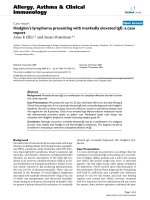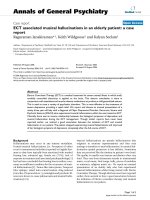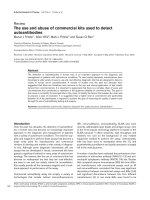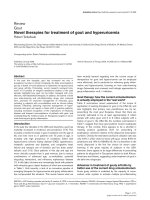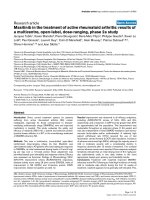Báo cáo y học: " Parenteral lidocaine for treatment of intractable renal colic: a case series" pps
Bạn đang xem bản rút gọn của tài liệu. Xem và tải ngay bản đầy đủ của tài liệu tại đây (277.14 KB, 4 trang )
CAS E REP O R T Open Access
Parenteral lidocaine for treatment of intractable
renal colic: a case series
Hassan Soleimanpour
1*
, Kamaleddin Hassanzadeh
2
, Dawood Agha Mohammadi
3
, Hassan Vaezi
1
and
Robab Mehdizadeh Esfanjani
4
Abstract
Introduction: We report a case series of successful treatment of intractable renal colic using parenteral lidocaine.
Case presentation: Because of inconsistent responses to standard treatment with opioids and non-steroidal anti-
inflammatory drugs in patients with renal colic pain, we decided to begin a trial of a single intravenous dose of
lidocaine (approximately 1.5 mg/kg) slowly in eight patients with intractable renal colic who were referred to our
emergency medicine department. The patients were six men and two women with a mean age at diagnosis of
34.62 years (age range, 28 to 42 years). The patients were of Iranian ethnic origin. The patients’ degree of pain,
based on Visual Analog Scale score upon entering our emergency medicine department, was recorded 10, 20, and
30 minutes after lidocaine injection. The patients’ degree of pain decreased from a mean Visual Analog Scale score
(±SD) of 8.87 ± 0.99 (95% confidence interval (95% CI) 8.04 to 9.70) to a mean Visual Analog Scale score (±SD) of
1 ± 2.82 (95% CI -1.36 to 3.36) before and 30 minutes after lidocaine treatment, respectively. Two of eight patients
experienced transient mild dizziness, and three of eight patients experienced minimal slurring of speech. No
patient experienced serious adverse events.
Conclusion: Parenteral lidocaine treatment can reduce pain dramatically or subtly.
Introduction
Numerous medications have been util ized for pain relief
in patients with renal colic; however, no medication has
yet been found to relieve pain quickly and completely. A
var iety of drugs are used to treat this condition, includ-
ing anti-spasmodics, non-steroidal anti-inflammatory
drugs (NSAIDs), and opioids [1]. Parenteral lidocaine
has been reported to be effective in small studies of var-
ious neuropathic pain conditions, including diabetic
neuropathy, post-operative pain, post-herpetic neuralgia,
centrally mediated pain, headache, and malignant nerve
infiltration [2-5].
Case presentation
Eight patients (mean age (±SD) 34.62 ± 4.34 years, six men
and two women) with intractable renal colic who pre-
sented to our emergency department were enrolled into
this study. All included patients previously underwent
therapy with morphine and NSAIDs previously but were
resistant to treatment. Adults with acute flank pain radiat-
ing to the groin, vomiting, and urinary symptoms were eli-
gible for inclusion in the study. Every aspect of the present
study was explained to the patients, and we obtained their
written consent for participation in the study. The diagno-
sis of renal stone was confimed by ultrasonsgraphy and by
the presence of red blood cells (RBCs) revealed by urinaly-
sis [6,7]. Because of patients’ inconsistent responses to
standard treatment with opioids and NSAIDs for renal
colic pain, the decision was made to begin a trial of a sin-
gle, slowly administered intravenous dose of lidocaine
(approximately 1.5 mg/kg) for these patients. As fluid ther-
apy is not commonly used in our center to trea t pat ients
with renal colic a nd is used only for pat ients who are
dehydrated or have sepsis, our patients received very little
fluid(10mL)administeredonly by injection [8]. The
mean pain degree reported by our patients was recorded
based on Visual Analog Scale (VAS) score before and 10,
20, and 30 minutes after injection (Table 1). The mean
VAS scores (±SD) decreased from 8.87 ± 0.99 (95% confi-
dence interval (95% CI) 8.04 to 9.70) to 1 ± 2.82 (95% CI
* Correspondence:
1
Emergency Medicine Department, Tabriz University of Medical Sciences,
Daneshgah Street, Tabriz 51664, Iran
Full list of author information is available at the end of the article
Soleimanpour et al. Journal of Medical Case Reports 2011, 5:256
/>JOURNAL OF MEDICAL
CASE REPORTS
© 2011 Soleimanpou r et al; licensee BioMed Central Ltd. This is an Open Access article distributed under the terms of the Creative
Commons Attribution License ( which permits unrestricted use, distribution, and
reproduction in any medium, provided the origina l work is properly cited.
-1.36 to 3.36) before and 30 minutes after receiving lido-
caine treatment, respectively. Colic pain disappeared com-
pletely within 10, 20, and 30 minutes in four of eight, six
of eight, and seven of eight patients, respectively. The vital
signs of the patients did not change during the 30 minutes.
Two of eight patients experienced transient mild dizziness,
and three of eight patients experienced minimal slurring
of speech. No patients experienced serious adverse events.
One patient needed another anodyne treatment after 30
minutes. For further studies, a kidney, ureter, and bladder
(KUB) X-ray was requested immediately for the patient
whowasresistanttolidocaine.However,fortheother
patients who had resp onded to lidocaine treatment, KUB
X-rays with previous preparation were requested, and the
results are presented in Table 2. Complete pain relief was
reported in seven of eight patients after lidocaine adminis-
tration, and this lasted until hospital discharge. These
patients were followed up by telephone for the following
24 hours. To reduce the risk of stone recurrence, all
patients were instructed to force oral hydration to produce
at least 2L/day urine after discharg e fro m the emergenc y
room. Six of the p atients reported that their renal colic
had not come back during the previous 24 hours, but one
patient who experienced renal colic rated his pain as 3 of
10 on the VAS. His pain was relieved by NSAID therapy.
Case 1 was a 31-year-old Iranian woman who was
referred to our emergency department because of refrac-
tory renal colic (resistant to mor phine and NSAIDs).
The patient had a history of renal colic, and, in spite of
receiving morphine and NSAIDS p reviously, she men-
tioned no decrease in h er degree of pain (VAS score 10
of 10). Her clinical examination revealed tenderness in
her left costovertebral angle (CVA) radiating to the gen-
italia, w hich was associated with dysuria, urination fre-
quency, and nausea. Abundant RBCs were detected by
urinalysis, and moderate hydronephrosis of the left kid-
ney was visualized by ultrasonography. After obtaining
written consent from the patient, lidocaine 1.5 mg/kg
was administered intravenously. Ten, twenty, and thirty
minutes after lidocaine treatment, the patient’ sVAS
scores decreased to 3 of 10, 0 of 10, and 0 of 10, respec-
tively. After lidocaine administration, the patient experi-
enced transient dizziness for less than one minute. The
patient was followed up in the hospital until she was
discharged. Follow-up was carried out by telephone for
more than 24 hours after discharge. The patient experi-
enced no colic pain during the follow-up period. On a
planned KUB X-ray requested the day after her dis-
charge from the emergency ward, a radiopaque stone
was observed.
Case 2 was a 32-year-old Iranian man who was referred
to our emergency department because of refractory renal
colic (resistant to morphine and NSAIDs). Despite the
fact that he had previously received treatment with mor-
phine and NSAIDs, he mentioned no regression in pain
degree (VAS score 9 of 10). His clinical examination
revealed tenderness in his right CVA radiating to the
genitalia, which was associated with dysuria, hematuria,
nausea, and vomiting. Abundant RBCs were revealed by
urinalysis, and moderate hydronephrosis of his right kid-
ney was visualized by ultrasonography. After obtaining
written consent from the patient, lidocaine 1.5 mg/kg
was administered intravenously. Ten, twenty, and thirty
minutes after lidocaine treat ment, the patient’ sVAS
scores decreased to 2 o f 10, 0 of 10, and 0 of 10, respec-
tively. The patient experienced transient dizziness and
slurring of speech lasting less than one minute after lido-
caine administration. He was followed up in the hospital
until he was discharged. The follow-up procedure was
continued by telephone for more than 24 hours after
Table 1 Visual Analog Scale score at each 10-minute interval
a
Before treatment 10 minutes after treatment 20 minutes after treatment 30 minutes after treatment
Mean VAS score ± SD 8.87 ± 0.99
(95% CI 8.04 to 9.70)
1.75 ± 2.18
(95% CI -0.07 to 3.57)
1.25 ± 2.81
(95% CI -1.10 to 3.60)
1 ± 2.82
(95% CI -1.36 to 3.36)
a
VAS, Visual Analog Scale; SD, standard deviation; 95% CI, 95% confidence interval.
Table 2 Individual patient characteristics
Case Age, years Gender Kind of Stone Stone side Stone condition Hydronephrosis
1 31 F Radiopaque Left RS Moderate
2 32 M Radiopaque Right FS Moderate
3 38 M Radiopaque Left RS Mild
4 28 F Radiolucent Right FS Mild
5 42 M Radiopaque Left FS Moderate
6 35 M Radiopaque Left FS Moderate
7 36 M Radiopaque Right FS Moderate
8 35 M Radiolucent Right RS Mild
RS:Recurrent Stone; FS:First Stone.
Soleimanpour et al. Journal of Medical Case Reports 2011, 5:256
/>Page 2 of 4
dis charge. The patient did not report any colic pain dur-
ing the foll ow-up period. On a planned KUB X-ray
requested the day after his discharge from the emergency
ward, a radiopaque stone was observed.
Case 3 was a 38-year-old Iranian man who was
referred to our emergency department because of refrac-
tory renal colic (resistant to morphine and NSAIDS).
The patient had a history of renal colic, and, in spite of
receiving treatment with morphine and NSAIDs pre-
viously, he had no r egression in pain degree (VAS score
10 of 10). His clinical examination revealed tenderness
in the left CVA radiating to the genitalia, which was
associated with dysuria, urination frequency, and nausea.
Abundant RBCs were reve aled by urinalysis, and mild
hydronephrosis of the left kidney was visualized by
ultrasonography. With the patient’ s written consent,
lidocaine 1.5 mg/kg was administered intravenously.
Ten, twenty, and thirty minutes after treatment, the
patient’s VAS scores decreased to 0 of 10, 0 of 10, and 0
of 10, respectively. After lidocaine administration, he
experienced no adverse events. The patient was followed
up in the hospital u ntil he was discharged. His follow-
up was extende d until the day after discharge and was
carried out by telephone. During the follow-up period,
the patient reported no colic pain. On a planned KUB
X-ray requested the day after his discharge from emer-
gency ward, a radiopaque stone was observed.
Case 4 was a 28-year-old Iranian woman who was
referred to our emergency department because of refrac-
tory renal colic (resistant to morphine and NSAIDs). In
spite of her previous treatment with mo rphine and
NSAIDs, she had no regression in pain degree (VAS score
9 of 10). Her clinical examination revealed tenderness in
her right CVA radiating to the genitalia, which was asso-
ciated with dysuria, urination frequency, and nausea.
Abundant RBCs were revealed by urinalysis, and mild
hydronephrosis of the right kidney was visualized by ultra-
sonography. The patient’s written consent was obtained,
and lido caine 1.5 mg/kg wa s administered intravenously.
Ten, twenty, and thirty minutes after treatment, the
patient’s VAS scores decreased to 0 of 10, 0 of 10, and 0 of
10, respectively. After lidocaine administration, she experi-
enced transient dizziness and slurring of speech for less
than one minute. The patient was followed up in the hos-
pital until she was discharged. Follow-up was extended
and carried out by telephone for more than 24 hours after
her discharge. She reported no colic pain during the fol-
low-up period. On a planned KUB X-ray requested the
day after her discharge from our emergency ward, a radi-
olucent stone was observed.
Case 5 was a 42-year-old Iranian man who was
referred to our emergency department because of refrac-
tory renal colic (resistant to mor phine and NSAIDs).
Although he had previouslyreceivedmorphineand
NSAIDs, he had no regression in pain degree (VAS
score 9 of 10). His clinical examination revealed tender-
ness in the left CVA radiating to the genitalia, which
was associated with dysuria, urination frequency, nausea,
and vomiting. Abundant RBCs were revealed by urinaly-
sis, and moderate hydronephrosis of the left kidney was
visualized by ultrasonography. Once the patient’s written
consent was obtained, lidocaine 1.5 mg/kg was adminis-
tered intravenously. Ten, twenty, and thirty minutes
after lidocaine treatment, the patient’ sVASscores
decreased to 3 of 10, 2 of 10, and 0 of 10, respectively.
After lidocaine administration, the patient did not
experience any adverse events. The patient was followed
up in the hospital until he was discharged. Follow-up
was continued by telephone for more th an 24 hours
after discharge. The patient reported no colic pain dur-
ing the follow-up period. On a planned KUB X-ray
requested the day after his discharge from our emer-
gency ward, a radiopaque stone was observed.
Case 6 was a 35-year-old Iranian man who was
referred to our emergency department because of refrac-
tory renal colic (resistant to morphine and NSAIDs). In
spite of receiving previous treatment with morphine and
NSAIDs, he had no regression in pain degree (VAS
score 7 of 10). His clinical examination revealed tender-
ness in the left CVA radiating to the genitalia, which
was associated with dysuria, urination frequency, nausea,
and vomiting. Abundant RBCs were detected by urinaly-
sis, and moderate hydronephrosis of the left kidney was
visualized by ultrasonography. After obtaining written
consent from the patient, lidocaine 1.5 mg/kg was admi-
nistered intravenously. Ten, twenty, and thirty minutes
after treatment, the patient’s VAS scores decreased to 0
of 10 , 0 of 10, and 0 of 10, respectively. After lidocaine
administration, the patient experienced no adverse
events. The patient was followed up in the hospital until
he was discharged. Follow-up was carried out by tele-
phone for more than 24 hours after he was discharged.
The patient reported no colic pain during the follow-up
period. On a planne d KUB X-ray requested the day
after his discharge from our emergency ward, a radiopa-
que stone was observed.
Case 7 was a 36-year-old Iranian man who was referred
to our emergency department because of refractory renal
colic (resistant to morphine and NSAIDs). He had pre-
viously been treated with morphine and NSAIDs, but he
had no regression in pain degree (VAS score 9 of 10). His
clinical examination revealed tenderness in his right CVA
radiating to the genitalia, which was associated with
hematuria, dysuria, and urination frequency. Abundant
RBCs were revealed by urinalysis, and moderate hydrone-
phrosis of the right kidney was visualized by ultrasono-
graphy. After obtaining the patient’ s written consent,
lidocaine 1.5 mg/kg was administered intravenously. Ten,
Soleimanpour et al. Journal of Medical Case Reports 2011, 5:256
/>Page 3 of 4
twenty, and thirty minutes after treatment, the patient’s
VAS scores decreased to 6 of 10, 8 of 10, and 8 of 10,
respectively. After lidocaine administration, the patient
did not experience any adverse events. Because of his
inconsistent response to lidocaine, this patient needed
additional anodyne treatment. A KUB X-ray was
requested immediately f or this patient for further study,
and a number of radiopaque stones were observed.
Case 8 was a 35-year-old Iranian man who was
referred to our emergency department because of refrac-
tory renal colic (resistant to mor phine and NSAIDs).
The patient had a history of renal colic, and, in spite of
receiving previous treatment with morphine and
NSAIDs, he had no regression in pain degree (VAS
score 8 of 10). His clinical examination revealed tender-
ness in the right CVA radiating to the genitalia, which
was associated with dysuria, urination frequency, nausea,
and vomiting. Abundant RBCs were revealed by urinaly-
sis, and moderate hydronephrosis of the right kidney
was visualized by ultrasonography. Once his written
consent was obtained, lidocaine 1.5 mg/kg was adminis-
tered intravenously. Ten, twenty, and thirty minutes
after treatment, the patient’s VAS scores decreased to 0
of 10 , 0 of 10, and 0 of 10, respectively. After lidocaine
administration, the patient experienced transient slur-
ring of speech for less than one minute. The patient was
followed up in the hospital until he was discharged. Fol-
low-up was carried out for more than 24 hours by tele-
phone while he was resting at home after discharge.
This patient experienced renal colic and rated his pain
as3of10ontheVASscale.Hispainwasrelievedby
administration of NSAIDs. On a planned KUB X-ray
requested the day after his discharge from our emer-
gency ward, a radiolucent stone was observed.
Conclusion
We have presented a short-lived but simple, inexpensive,
low-risk, and effective technique for treating pain asso-
ciated with intractable renal colic. Lidocaine is effective
for treating patients with visceral or central pain [2].
Lidocaine has been hypothesized to alter sympathetic
tone to the smooth muscle by suppres sing transmission
through afferent sensory pathways [9]. Parenteral lido-
caine can reduce pain dramatically or subtly. Parenteral
lidocaine is useful when opioids are ineffective or cause
unacceptable adverse effects [2].
Consent
Written informed consent was obtained from the patient
for publicatio n of this case report and any accompany-
ing images. A copy of the written consent is available
for review by the Editor-in-Chief of this journal.
Abbreviations
KUB: kidney, ureter, and bladder X-ray; NSAIDs: non-steroidal anti-
inflammatory drugs; RBC: red blood cell; RS: recurrent stone; VAS: Visual
Analog Scale; FS: first stone.
Author details
1
Emergency Medicine Department, Tabriz University of Medical Sciences,
Daneshgah Street, Tabriz 51664, Iran.
2
Urology Department, Tabriz University
of Medical Sciences, Daneshgah Street, Tabriz 51664, Iran.
3
Anesthesiology
Department, Tabriz University of Medical Sciences, Daneshgah Street, Tabriz
51664, Iran.
4
Department of Statistics, Tehran North Branch, Islamic Azad
University, Tehran, Iran.
Authors’ contributions
HS, KH, DA, and HV collected clinical data, reviewed the literature on the
topic, and drafted the manuscript. RME analyzed and interpreted the patient
data. All of the authors were involved in patient management or the writing
of the manuscript. All authors read and approved the final manuscript.
Competing interests
The authors declare that they have no competing interests.
Received: 20 July 2010 Accepted: 29 June 2011 Published: 29 June 2011
References
1. Labrecque M, Dostaler LP, Rousselle R, Nguyen T, Poirier S: Efficacy of
nonsteroidal anti-inflammatory drugs in the treatment of acute renal
colic: a meta-analysis. Arch Intern Med 1994, 154:1381-1387.
2. Ferrini R, Paice JA: How to initiate and monitor infusional lidocaine for
severe and/or neuropathic pain. J Support Oncol 2004, 2:90-94.
3. Wolff RF, Bala MM, Westwood M, Kessels AG, Kleijnen J: 5% lidocaine
medicated plaster in painful diabetic peripheral neuropathy (DPN): a
systematic review. Swiss Med Wkly 2010, 140:297-306.
4. Schwartzman RJ, Patel M, Grothusen JR, Alexander GM: Efficacy of 5-day
continuous lidocaine infusion for the treatment of refractory complex
regional pain syndrome. Pain Med 2009, 10:401-412.
5. McKay A, Gottschalk A, Ploppa A, Durieux ME, Groves DS: Systemic
lidocaine decreased the perioperative opioid analgesic requirements but
failed to reduce discharge time after ambulatory surgery. Anesth Analg
2009, 109:1805-1808.
6. Marx J, Hockberger R, Walls R: Rosen’s Emergency Medicine: Concepts and
Clinical Practice. 7 edition. Philadelphia: Mosby; 2010, 1309-1311.
7. Pervez A, Arif A: Role of ultrasound in evaluation of renal colic and
assessment of risk factor for renal calculi. Gomal J Med Sci 2007, 5:22-27.
8. Purohit RS, Stoller ML: Renal colic resulting from renal calculus disease. In
Urological Emergencies: A Practical Guide. Edited by: Wessells H, McAninch
JW. Totowa, NJ: Humana Press; 2005:241-262.
9. Rimbäck G, Cassuto J, Tollesson PO: Treatment of postoperative paralytic
ileus by intravenous lidocaine infusion. Anesth Analg 1990, 70:414-419.
doi:10.1186/1752-1947-5-256
Cite this article as: Soleimanpour et al.: Parenteral lidocaine for
treatment of intractable renal colic: a case series. Journal of Medical Case
Reports 2011 5:256.
Submit your next manuscript to BioMed Central
and take full advantage of:
• Convenient online submission
• Thorough peer review
• No space constraints or color figure charges
• Immediate publication on acceptance
• Inclusion in PubMed, CAS, Scopus and Google Scholar
• Research which is freely available for redistribution
Submit your manuscript at
www.biomedcentral.com/submit
Soleimanpour et al. Journal of Medical Case Reports 2011, 5:256
/>Page 4 of 4


